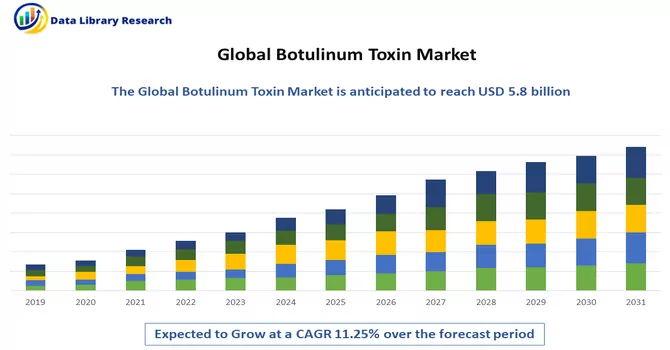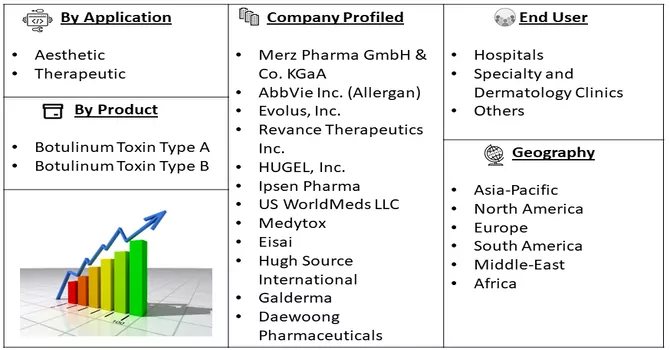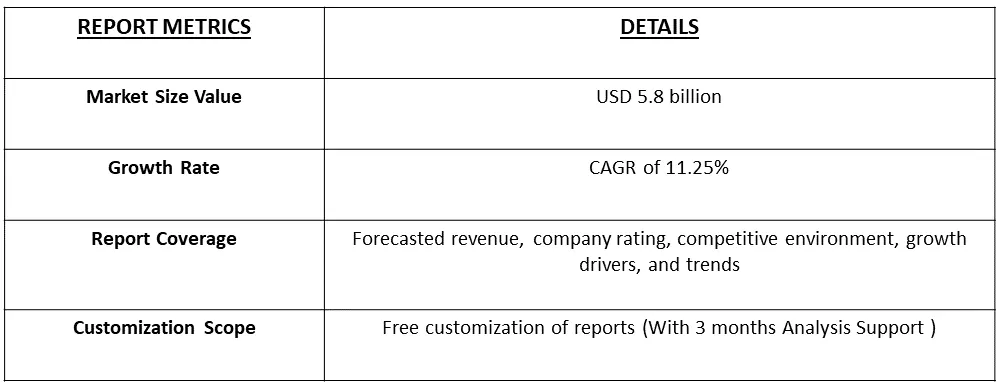The botulinum toxin market was valued at USD 5.8 billion in the base year 2023, and it is expected to register a CAGR of 11.25% during the forecast period, 2024-2031.

Get Complete Analysis Of The Report - Download Free Sample PDF
Botulinum toxin is a neurotoxic protein produced by the bacterium Clostridium botulinum. It is one of the most potent toxins known and can cause botulism, a severe and potentially life-threatening illness. Botulinum toxin works by blocking nerve signals in the muscles where it is injected, leading to temporary muscle paralysis. This property has made it useful in medical and cosmetic applications. In medicine, botulinum toxin is commonly used for various therapeutic purposes, such as treating muscle spasms, chronic migraines, and certain neurological disorders. Additionally, it is widely known for its cosmetic applications, particularly in the form of Botox injections, which are used to reduce the appearance of wrinkles and fine lines by temporarily paralyzing facial muscles. Despite its potential therapeutic benefits, botulinum toxin is extremely potent, and its use should be carefully regulated and administered by trained professionals to avoid complications and side effects. When ingested in contaminated food, botulinum toxin can lead to severe illness, and even death, due to its ability to interfere with nerve function and cause muscle paralysis.
The rise of medical tourism, where individuals travel to other countries for medical and cosmetic procedures, has expanded the market for botulinum toxin. Accessible and cost-effective treatments in certain regions attract international patients seeking cosmetic enhancements. Ongoing research and development efforts to explore new applications, formulations, and delivery methods for botulinum toxin contribute to the market's growth by expanding its potential uses and addressing evolving consumer needs. Furthermore, the globalization of beauty standards and the influence of social media have led to a more uniform perception of beauty across different regions. This has resulted in a broader and more consistent demand for cosmetic procedures, including botulinum toxin treatments.
Market Segmentation: The report covers Global Botulinum Toxin Market is Segmented by Application (Cosmetic Applications (Glabellar Lines, Lateral Canthal Lines, Forehead lines, and Other Cosmetic Applications), Non-cosmetic Applications (Dystonia, Chronic Migraine, Ophthalmologic Disorders, and Other Non-Cosmetic Applications)), and Geography (North America, Europe, Asia-Pacific, Middle East and Africa, and South America). The market size and forecasts are provided in terms of value (USD million) for all the above segments.

For Detailed Market Segmentation - Download Free Sample PDF
The botulinum toxin market is experiencing notable trends that reflect the evolving landscape of aesthetic medicine. There is a rising interest in preventive aesthetics, with younger individuals seeking early intervention to forestall wrinkles. Combination therapies, integrating botulinum toxin with other aesthetic procedures, are gaining popularity for more comprehensive results. Natural-looking outcomes are becoming a priority, shifting away from frozen appearances. Personalized treatment plans, considering individual factors, are on the rise, and the male aesthetics market is expanding. Ongoing innovations focus on new formulations and delivery methods, leveraging technology for assessment and simulation. Safety and minimal downtime are emphasized, and regulatory landscapes are adapting to market dynamics. With a global market expansion, the botulinum toxin market reflects a dynamic industry responding to changing consumer preferences and advancements in medical technology.
Market Drivers:
Increasing Demand for Aesthetic Procedures
The botulinum toxin market is experiencing notable trends that reflect the evolving landscape of aesthetic medicine. There is a rising interest in preventive aesthetics, with younger individuals seeking early intervention to forestall wrinkles. Combination therapies, integrating botulinum toxin with other aesthetic procedures, are gaining popularity for more comprehensive results. Natural-looking outcomes are becoming a priority, shifting away from frozen appearances. Personalized treatment plans, considering individual factors, are on the rise, and the male aesthetics market is expanding. Ongoing innovations focus on new formulations and delivery methods, leveraging technology for assessment and simulation. Safety and minimal downtime are emphasized, and regulatory landscapes are adapting to market dynamics. With a global market expansion, the botulinum toxin market reflects a dynamic industry responding to changing consumer preferences and advancements in medical technology.
Growing Therapeutics Usage of Botulinum Toxin
The market is poised for growth not only due to increased demand for cosmetic applications but also owing to the expanding therapeutic usage of botulinum toxin in non-cosmetic procedures. Conditions such as dystonia and migraines are emerging as key therapeutic areas, contributing to the market's upward trajectory. The prevalence of disorders suitable for botulinum toxin therapy is expected to be a significant growth driver, supported by findings from an international cross-sectional cohort study published by AAN in January 2021, which reported a varying prevalence of dystonia tremor between 36.9% and 48.4% in the United States. Additionally, the market is expected to benefit from a surge in clinical trials exploring the potential of botulinum toxin in treating various diseases. This multifaceted approach, combining therapeutic applications with a growing body of clinical evidence, is likely to fuel the demand for botulinum toxin and drive the market's expansion over the forecast period.
Market Restraints:
High cost of Botulinum Toxin Procedures
The high cost associated with botulinum toxin procedures stands as a potential impediment to the growth of the botulinum toxin market. While these procedures are sought after for their efficacy in cosmetic and therapeutic applications, the substantial expense involved may deter a portion of the consumer base. The financial considerations associated with botulinum toxin treatments can limit accessibility, particularly for individuals with budget constraints or those not covered by comprehensive healthcare plans. Moreover, the cost factor may influence the decision-making process of potential patients, leading them to explore alternative, more affordable treatments or postpone procedures altogether. As the market navigates these pricing challenges, efforts to address cost concerns and make botulinum toxin procedures more financially accessible may become crucial for sustaining and expanding the market in the future.
The COVID-19 pandemic exerted a substantial influence on the market growth of botulinum toxin during the crisis. This impact stemmed from a decline in botulinum toxin procedures, primarily attributable to the stringent lockdown measures and the deferral of non-elective surgeries, including cosmetic procedures. As an illustration, a report from the American Society of Plastic Surgeons revealed a notable reduction, with approximately 4,401,536 minimally-invasive procedures involving Botulinum Toxin Type A conducted in 2020. This represented a 13% decrease compared to the preceding year's figures for Botulinum Toxin Type A procedures. The imposition of lockdown restrictions and the postponement of elective surgeries had a ripple effect on the cosmetic industry, causing a decline in the number of botulinum toxin procedures performed. These findings, as reported by the American Society of Plastic Surgeons, underscore the pandemic's significant impact on the market dynamics, reflecting the challenges faced by the cosmetic and aesthetic medical sectors during the COVID-19 period.
Segmental Analysis:
Glabellar Lines Segment is Expected to Witness Significant Growth over the Forecast Period
The segment focusing on glabellar lines is anticipated to command a significant market share throughout the forecast period, with botulinum toxin-A emerging as the preferred non-surgical solution for enhancing the appearance of these lines. Glabellar lines, commonly referred to as the 'eleven,' represent vertical lines that develop between the eyebrows due to facial expressions like frowning, scowling, or intense concentration during activities like reading or listening. The persistent muscle contractions in this region lead to the loss of skin elasticity, resulting in the formation of deep wrinkles that may even be noticeable when the muscles are at rest. Various factors contribute to the increased prominence of glabellar lines, including natural aging, prolonged exposure to harsh sunlight, and mental stress. The prevalence of these lines is expected to drive the demand for botulinum toxin treatments, thereby fostering market growth. The positive impact on the market is further augmented by the ongoing launch of products and approvals specifically designed for treating glabellar lines. For instance, in September 2022, the United States Food and Drug Administration (USFDA) granted approval for daxibotulinumtoxinA-Ianm injection (Daxxify) to temporarily enhance the appearance of moderate to severe glabellar lines in adults. Similarly, in June 2022, Galderma reported promising topline results from two phase-3 clinical studies, indicating that RelabotulinumtoxinA effectively improves glabellar lines with a rapid onset of action and a lasting duration of up to six months. Thus the growing demand for glabellar lines treatment, coupled with the introduction of efficacious botulinum toxin products tailored for this purpose, is poised to be a key driver in the expansion of the botulinum toxin market during the forecast period.
North America Region is Expected to Witness Significant Growth Over the Forecast Period
North America is poised to be the dominant force in the global botulinum toxin market throughout the forecast period, with several key factors driving its growth in the region. The increasing demand for aesthetic procedures, coupled with a high prevalence of various disorders suitable for botulinum toxin therapy, is expected to fuel market expansion. In 2020, the American Society of Plastic Surgeons reported a substantial number of botulinum toxin procedures in the United States, with over 4.1 million performed on females and more than 265,000 on males as part of cosmetic minimally invasive procedures. A 2022 survey by the American Society of Plastic Surgeons revealed that individuals aged 31 to 45 predominantly sought botulinum toxin type A cosmetic procedures.
This rising adoption is anticipated to propel market growth in the region. Moreover, North America is witnessing an influx of product launches and approvals for both cosmetic and non-cosmetic applications. Notably, in March 2022, Aquavit Pharmaceuticals, Inc submitted its New Drug Application for botulinum toxin (DTX-021) to the Food and Drug Administration, targeting the treatment of moderate to severe glabellar lines. This follows the exclusive license acquisition by Aquavit Holdings LLC in April 2021 for registering, marketing, and commercializing DTX-021 in the United States and Canada. The continuous introduction of new products and the presence of major market players are expected to further contribute to the market's growth in North America. These factors collectively underscore the region's significance as a key driver in the global botulinum toxin market.

Get Complete Analysis Of The Report - Download Free Sample PDF
The botulinum toxin market exhibits a moderately fragmented nature owing to the presence of numerous market players. The competitive landscape is characterized by an analysis of both international and local companies, each vying for market shares. This diversity of players contributes to a dynamic and competitive environment within the industry. The presence of various companies, both on a global and regional scale, highlights the multifaceted nature of the market, with each player striving to establish and strengthen its foothold in the evolving landscape of botulinum toxin applications. The competition among these entities fosters innovation, drives research and development initiatives, and ultimately benefits consumers by providing a range of options and advancements in botulinum toxin-based products and therapies. Some of the market players working in this market are:
Recent Development:
1) In October 2022, Hugel announced that the US Food and Drug Administration (FDA) has accepted its Biologics License Application for letibotulinumtoxinA. The FDA categorized the resubmission as a Class 2 response and has set an action date of April 6, 2023, in accordance with the Prescription Drug User Fee Act (PDUFA).
2) In July 2022, Fastox Pharma introduced its groundbreaking long-lasting botulinum toxin technology, LAST, at the 'Toxins 2022 International Conference.' The innovation involves combining botulinum toxin type A (BoNT/A) with fast-acting myorelaxant drugs, with the aim of expediting the onset of action for BoNT/A. This development showcases ongoing advancements in the field, reflecting a strategic approach to enhance the efficacy and efficiency of botulinum toxin treatments.
Q1. What was the Botulinum Toxin Market size in 2023?
As per Data Library Research the botulinum toxin market was valued at USD 5.8 billion in the base year 2023.
Q2. At what CAGR is the Botulinum Toxin market projected to grow within the forecast period?
Botulinum Toxin Market is expected to register a CAGR of 11.25% during the forecast period.
Q3. Which region has the largest share of the Botulinum Toxin market? What are the largest region's market size and growth rate?
North America has the largest share of the market. For detailed insights on the largest region's market size and growth rate request a sample here.
Q4. What are the factors driving the Botulinum Toxin market?
Key factors that are driving the growth include the Increasing Demand for Aesthetic Procedures and Growing Therapeutics Usage of Botulinum Toxin.
Data Library Research are conducted by industry experts who offer insight on industry structure, market segmentations technology assessment and competitive landscape (CL), and penetration, as well as on emerging trends. Their analysis is based on primary interviews (~ 80%) and secondary research (~ 20%) as well as years of professional expertise in their respective industries. Adding to this, by analysing historical trends and current market positions, our analysts predict where the market will be headed for the next five years. Furthermore, the varying trends of segment & categories geographically presented are also studied and the estimated based on the primary & secondary research.
In this particular report from the supply side Data Library Research has conducted primary surveys (interviews) with the key level executives (VP, CEO’s, Marketing Director, Business Development Manager and SOFT) of the companies that active & prominent as well as the midsized organization
FIGURE 1: DLR RESEARH PROCESS

Extensive primary research was conducted to gain a deeper insight of the market and industry performance. The analysis is based on both primary and secondary research as well as years of professional expertise in the respective industries.
In addition to analysing current and historical trends, our analysts predict where the market is headed over the next five years.
It varies by segment for these categories geographically presented in the list of market tables. Speaking about this particular report we have conducted primary surveys (interviews) with the key level executives (VP, CEO’s, Marketing Director, Business Development Manager and many more) of the major players active in the market.
Secondary ResearchSecondary research was mainly used to collect and identify information useful for the extensive, technical, market-oriented, and Friend’s study of the Global Extra Neutral Alcohol. It was also used to obtain key information about major players, market classification and segmentation according to the industry trends, geographical markets, and developments related to the market and technology perspectives. For this study, analysts have gathered information from various credible sources, such as annual reports, sec filings, journals, white papers, SOFT presentations, and company web sites.
Market Size EstimationBoth, top-down and bottom-up approaches were used to estimate and validate the size of the Global market and to estimate the size of various other dependent submarkets in the overall Extra Neutral Alcohol. The key players in the market were identified through secondary research and their market contributions in the respective geographies were determined through primary and secondary research.
Forecast Model
